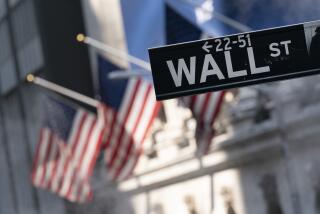Investors in Small Stocks Get a Jump on ‘January Effect’
- Share via
Is Wall Street trying to cash in on the “January effect” in small stocks three months before the fact?
Notwithstanding the last two days’ profit taking in the Nasdaq market, small stocks’ hefty gains this month hint at an attempt to front-run January’s historically strong performance. And if that’s true, it raises the possibility of dwindling small-stock returns until perhaps February.
The January effect “is definitely on institutional minds,” says Jim Troyer, manager of the Vanguard Small Cap stock fund in Valley Forge, Pa.
Before every stock market columnist and his brother began writing about the J-effect in the mid-1980s, only a relative few professionals knew that small stocks’ best month of the year usually was January.
Here’s how the J-effect worked:
Tax-related selling at the end of each calendar year--i.e., investors realizing capital losses for tax purposes--usually depressed smaller issues unduly, because of their thin trading action.
Once the calendar changed to January, however, buyers often flooded back into smaller stocks. The catalyst frequently was nothing more than a dose of New Year’s optimism about the economy and corporate profit growth. In any case, the buying often was enough to goose beaten-down small-stock prices across the board.
*
But as the Nasdaq market’s tendency to rise in January became well-publicized in the late-1980s, some savvy buyers began to target small stocks in December, essentially “front-running” expected January gains.
And last year, the Nasdaq market got a huge lift in November. President Clinton’s election certainly helped the stock market as a whole, but a not-infrequent post-election comment last year by portfolio managers was that one might as well buy small stocks in November--before the J-effect front-runners swarmed in December.
The end result of this front-running: The J-effect has dwindled in magnitude each year since 1991. The Nasdaq composite index jumped 10.8% in January, 1991. But in 1992, the month’s gain was 5.8%. This year, it was just 2.9%.
Now, this isn’t to suggest that the J-effect is all that matters in the Nasdaq market at this time of year. Obviously, what really drives stocks are earnings expectations and investors’ general mood. Those two factors can overwhelm any calendar-related effects on Nasdaq shares.
(Indeed, when those factors are negative, there is no J-effect at all--as in January, 1990, for example, when the Nasdaq index tumbled 8.6%.)
Still, the buying frenzy in the Nasdaq market this month has more than a few small-stock fund managers assuming that some of the demand is from traders trying to front-run the front-runners. “We know the January effect happens earlier and earlier,” notes Stu Roberts, manager of the Montgomery Small Cap fund in Denver.
The Nasdaq index shot up 3.2% between Sept. 30 and last Friday, to a record high--even though Wall Street is supposed to be frightened of October because of its reputation for hosting market panics. After the profit taking that hit Monday and Tuesday, though, the Nasdaq index now is up just 0.8% for the month, but 13.6% for the year.
If too many potential buyers have already exhausted their ammo (cash) in the Nasdaq market, it’s possible that November and December could be disappointing for small stocks. And the J-effect this time could be nonexistent.
Does that matter to most small-stock investors? If you’re a short-term trader, it might. But long-term investors should realize that Wall Street continues to bet heavily that we’re in an extended bull market in small stocks. Unless the bottom falls out between now and year’s end, this will be the third-straight year that smaller stocks outperform blue chips.
If you believe, as many pros do, that small companies have inherent advantages over bigger firms in a slow-growing economy, any setback for smaller stocks in the months ahead would be a great time to buy.
. . . But Wait Till January?: All investors who are contemplating small-stock mutual fund purchases should remember that most stock funds will be paying out capital gains in December. That means any fund purchase now could turn into an instant tax liability on your 1993 tax return.
Why? If a fund’s share price now is, say, $22, it might have $2 in accumulated capital gains built in. That means $2 a share will be paid out to fund owners, most likely in December. The share price then will drop to $20. If you buy now, you’ll owe taxes on the fund’s gain for the entire year--even though you’re a new investor.
In the long run, this may not matter. But from a tax point of view, it may be smarter to make major stock fund purchases after Jan. 1.
Betting on Nasdaq
January has historically been a good month for small stocks on the Nasdaq market. So in recent years, some investors have tried to get in early--resulting in bigger Nasdaq gains in November and December, smaller gains in January.
Nasdaq composite index, monthly changes
Years Nov. Dec. Jan. ‘85-’86 +7.3% +3.5% +3.3% ‘86-’87 -0.3 -3.0 +12.4 ‘87-’88 -5.9 +8.3 +4.3 ‘88-’89 -2.9 +2.7 +5.2 ‘89-’90 +0.1 -0.3 -8.6 ‘90-’91 +8.9 +4.1 +10.8 ‘91-’92 -3.5 +11.9 +5.8 ‘92-’93 +7.9 +3.7 +2.9
Source: National Assn. of Securities Dealers
More to Read
Inside the business of entertainment
The Wide Shot brings you news, analysis and insights on everything from streaming wars to production — and what it all means for the future.
You may occasionally receive promotional content from the Los Angeles Times.










